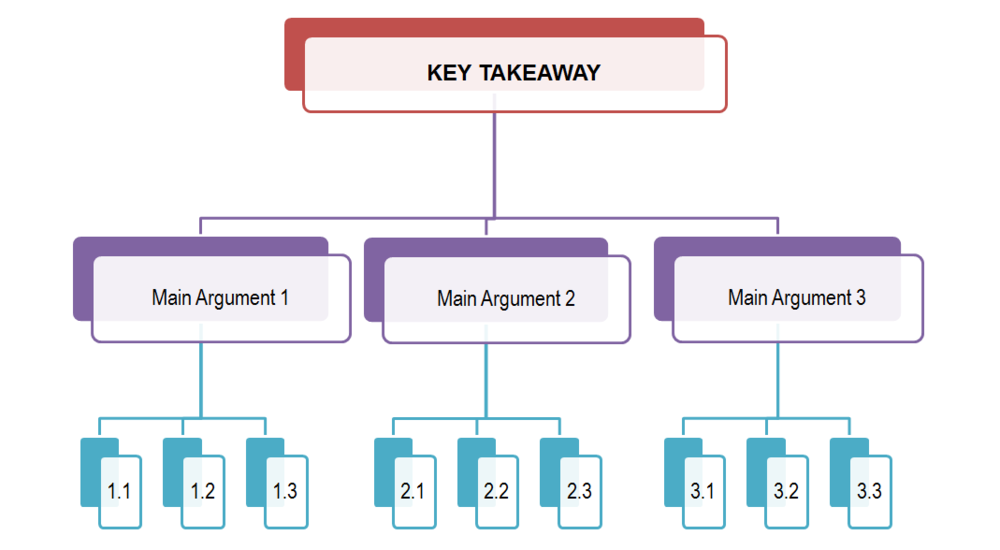The Pyramid Principle encapsulates an efficient, functional way of communicating, where you deliver key conclusions first and then go on to supply supporting information.
We can use the pyramid principle in many different contexts, but it is particularly crucial to adhere to in delivering your client recommendation at the end of your case study.
The Pyramid Principle is a famous book by Barbara Minto on the McKinsey method for effective communication. Minto's book also gives us the MECE rule, with the volume’s contents becoming ubiquitous in consulting and often being repackaged for audiences in other areas. The book is over 200 pages long, but what you really need to know for your case interview is synthesized in this article.
For a more detailed and comprehensive discussion of all of these principles, refer to our MCC Academy course.
Adapting your approach and strategy to your audience
Before we get into the detail of how we can actually employ the pyramid principle in a case interview, we should consider why we need to communicate differently in a consulting context. The first step to effective communication in any sphere is to be aware of your audience and their particular demands.
Looking for an all-inclusive, peace of mind program?
Choose our mentoring programs to get access to all our resources, a customised study plan and a dedicated experienced MBB mentor Learn moreConsider the audience faced by a working consultant. Working on projects, they will have to present their findings to busy C-level executives - individuals who are obliged to place a high premium on their own time and attention. In your interview, you should be aiming to communicate like a working consultant. You'll also be dealing with consulting partners, who work with CEOs every day and have personally come to share their manner and approach - in particular their focus on time-efficiency.
The implication of all this is that, frequently, the most challenging constraint you’ll face is time. At the end of your case, you will be expected to deliver a concise and clear main recommendation from your analysis. If your interviewer is interested, they’ll ask for details in specific areas. This is referred to as a “top-down” manner of communication. Remember - executives want to focus on the big, strategic questions - and they want answers to these without getting bogged down in details.
An AI-based, bespoke preparation plan
We’re all trying to get to the same place, but from different starting points. MCC automatically tailors your preparation to your own specific needs. Get startedHow to use the Pyramid Principle
Now we understand what our audience expects. How can we use the pyramid principle to provide the kind of recommendation that will get you a job?
The basic approach is very simple:
- Start with the answer to the executive’s question first.
- State your (preferably 3) MECE supporting arguments
- After stating each supporting argument, state the facts related to them
This sounds fairly intuitive. However, especially for those just out of college or with a scientific or engineering background, this represents the opposite of the approach they will have always used in academic or technical contexts. If you read an academic paper, you find the conclusion at the end. The flow is very logical in itself: you start by reciting all of the facts, recounting all of the analyses, and reviewing all of the supporting ideas. Then you get to the punch line. However, this is the opposite of what the pyramid principle requires!
Join thousands of other candidates cracking cases like pros
At MyConsultingCoach we teach you how to solve cases like a consultant Get startedThe main problems of the Pyramid Principle - how to build your pyramid
There are two main problems that candidates run into when it comes to supplying a properly structured, top-down recommendation at the end of their case. Let's look at both in turn:
1. Answer the question!
The basic requirement for any use of the pyramid principle is being crystal clear on the main question you are expected to answer. This is crucial. If you don’t have the question right, your main point at the top of the pyramid will be irrelevant.
Despite this being logically obvious, it nevertheless proves to be a major stumbling block for many candidates arriving at the end of their case.
We have a whole article devoted to how to properly identify the problem at the start of the case. However, even where candidates start off working on the correct question, it is not uncommon for them to drift off course - disappearing off on a tangent and losing sight of the main question by the end of their analysis.
Whatever you deliver to the interviewer in this case, it will not be the kind of efficient, top-down answer that is expected. Either you will give a structured answer to a question that wasn't asked, or you will realize what has happened and end up trying to fudge an answer without having done the required work to back it up (and with that answer very probably being entirely incorrect).
In consulting, everything is about not "boiling the ocean", and your interviewer will clearly not be impressed with running useless analysis, even if that analysis was insightful in itself. Avoiding this common mistake requires a strong focus on the main problem. You should refer to our article on the hypothesis driven approach to help you keep the client's question in mind throughout the case.
2. Grouping facts
The previous error can be thought of as a failure to set the top of the pyramid in place. By contrast, this error is the failure to properly arrange the components on the lower levels - to actually build the pyramid under its peak.
Under the pyramid principle, facts are grouped together under supporting arguments - usually in sets of three. This makes it easy for the CEO or interviewer to understand the relevance of the facts to the overall point you are making.
Everything you need in one place
All the most up-to-date resources delivered as a MBA course Learn moreOne of the most common mistakes is stating facts in an unstructured “laundry list” or “flow of consciousness” style. This has two key drawbacks. First, it prevents interviewers from properly understanding the relevance of facts for the points you are making. Second, it leads interviewers and CEOs to disengage from the conversation and think about other more pressing issues. Bottom line: you failed to convey your message.

A final point on brainstorming
As we stress repeatedly, communication is absolutely crucial in consulting. Even the best analysis coupled with ineffective, unstructured communication is still a recipe for failure. However, there will be times when you are simply brainstorming potential ideas with the interviewer and your process will likely not to be very structured. Is there a more structured alternative? What about spending the time in silence before coming up with a structured answer at the end?
We strongly suggest you don't do this, for two reasons. First, you prevent the interviewer from understanding the way you think and, second, you can't do the same in front of a real client.
So, how to reconcile relatively unstructured brainstorming with the Pyramid Principle? The answer is that, once you are finished brainstorming, you should summarize your key findings in line with the Pyramid Principle. Not only will you showcase excellent communication skills, but you'll also signal your ability to synthesize disparate parts of the problem and connect them back to the grand scheme of the case as a whole.
Takeaway
The consulting world demands a particular style of communication. Especially when delivering the client recommendation at the end of your case study, you will be expected to communicate in a highly efficient, top-down manner.
Barbara Minto's pyramid principle gives us a simple method to do just this. Despite the pyramid structure being relatively straightforward in itself, the style of communication it represents is very different from how candidates will be accustomed to communicating in other spheres, and candidates will often make mistakes when using it.
We examined two particularly common mistakes in delivering appropriately structured client recommendations and noted how these can be avoided. In particular, we noted the importance of always maintaining an hypothesis driven approach. As such, you should make sure that you are familiar with our article on the hypothesis driven approach if you are not already.
It is only possible to give a brief overview of principles in articles like this one. The MCC Academy provides a much more comprehensive and detailed treatment of the pyramid principle and other essential ideas for success in your consulting interview.
Find out more in our case interview course
Ditch outdated guides and misleading frameworks and join the MCC Academy, the first comprehensive case interview course that teaches you how consultants approach case studies.




